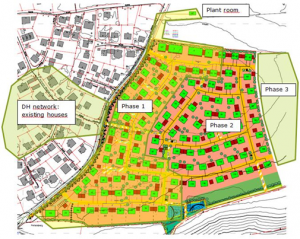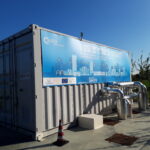A new rural district heating network in Nurnberg region (Germany)
 The municipality of Windsbach (6000 inhabitants, located 35 km south west of Nuremberg) developed a new residential housing project in a rural area and heated by district heating.
The municipality of Windsbach (6000 inhabitants, located 35 km south west of Nuremberg) developed a new residential housing project in a rural area and heated by district heating.
For the heat supply of a development area with many single-family houses, a sustainable and affordable solution had to be found. With a view to sustainability, the administration of the town decided against making natural gas available in the residential area, and implementing a district heating network fueled by a bio gas co-generation plant instead.
There are two types of district heating networks, central and decentralized.
- In a central heating network, heat consumers have a relatively simple heat exchanger in their homes, with which they take heat from the network just when they need it. Consequently, the heating network has to be able to provide heat at every time of the day.
- In a decentralized heating network, each consumer installs a buffer storage tank. The domestic heat requirement is covered by the stored warm water, which in turn is being replaced with hot heating network water when it has spent its warmth. The heat network may be turned off when there’s no heat demand, e.g. during summer nights. This way, heat losses of the network as well as its energy consumption for pumps may be significantly reduced. This concept works especially well in smaller and medium-sized networks with less than one hundred connected consumers.
Another advantage of decentralized heating networks is that houses may be connected with smaller pipes than with centralized networks. Short heat demand peaks can be fed from the buffer, whereas with a centralized network the connection must be designed for the higher output of these peaks.
Therefore a decentralized district heating network was installed in Windsbach.
The newly built houses meet high thermal insulation standards, so they require relatively little heat. At the same time, there is a clear tendency towards smaller houses, with little space for a buffer tank and the rest of the domestic heating equipment.
 Need for an innovation – compact buffer units with preinstalled heating equipment
Need for an innovation – compact buffer units with preinstalled heating equipment
As a solution, ENERPIPE developed a compact buffer tank unit with specifically small footprint, able to meet the smaller heat demand of a modern single-family home, and at the same time including the required heat exchangers, pumps and auxiliaries to provide not only heating, but also domestic hot water.
Its dimensions correspond to those of a refrigerator and therefore fit into a small utility room or even a niche in more frequented rooms.
By coordinating the charging cycles of the decentralized buffers, a controller that had been previously developed in the Horizon 2020 STORM project and was specifically adapted to the Windsbach project, is able to decrease the total peak heat load in the grid. To achieve this, a 24h forecast of the total heat load is calculated together with individual heat load forecasts of all the connected buffers.
The controller uses these forecasts to calculate an optimal charging plan for the total network which is disaggregated and dispatched to each decentralized buffer individually. A backup controller ensures that safety and comfort boundaries are never compromised. It forces a charging cycle if the buffer temperatures are too cold and block the charging cycle when buffer temperatures are too high.
To supervise the effects of the innovation and the good operation of the network, each consumer’s equipment may be monitored via central computer.
With these two innovations combined, many of the advantages of a decentralized heating network may be combined with the small space demand of a centralized network’s heat transfer station, providing a sustainable and affordable solution for residential neighborhoods with many single family houses.
A detailed report of the final results from the integrated innovations is available here.
